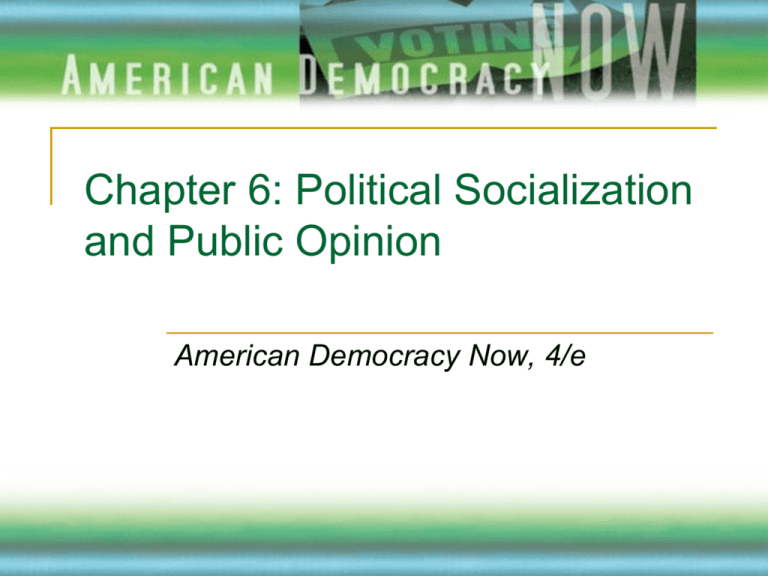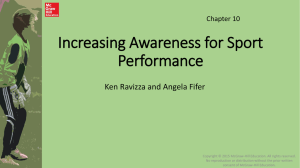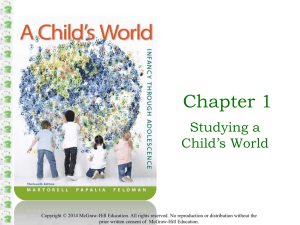
Chapter 6: Political Socialization
and Public Opinion
American Democracy Now, 4/e
Political Socialization and Civic
Participation
The process by which we develop our political
values and opinions is called political
socialization.
A key aspect of political socialization is whether
children are socialized to participate in politics.
Copyright © 2015 McGraw-Hill Education. All rights reserved. No
reproduction or distribution without the prior written consent of McGrawHill Education.
The Process of Political Socialization
Family and school have the strongest
influence on political socialization.
In recent times, media have become one
of the prime agents of political
socialization.
Copyright © 2015 McGraw-Hill Education. All rights reserved. No
reproduction or distribution without the prior written consent of McGrawHill Education.
Participating in Civic Life
Children whose parents are active in politics or
in their community are more likely to be active
themselves.
Schools also play an important role in socializing
young people to become active in civic life.
Research also indicates that socialization
actually generates participation.
There is a strong link between being informed
and the likelihood of engaging in civic
participation.
Copyright © 2015 McGraw-Hill Education. All rights reserved. No
reproduction or distribution without the prior written consent of McGrawHill Education.
Agents of Socialization
Learning, culture, and socialization occur
through agents of socialization, the individuals,
organizations, and institutions that facilitate the
acquisition of political views.
Copyright © 2015 McGraw-Hill Education. All rights reserved. No
reproduction or distribution without the prior written consent of McGrawHill Education.
Family Influences on Activism and
Attitudes
We learn whether our family members value
civic activism by observing their actions and
listening to their views.
Our families also influence what we believe.
While parents or older siblings may discuss
specific issues or policies, their attitudes and
outlook also shape children’s general political
attitudes and ideology.
The Weekly Reader poll.
Copyright © 2015 McGraw-Hill Education. All rights reserved. No
reproduction or distribution without the prior written consent of McGrawHill Education.
The Media’s Ever-Increasing Role
in Socialization
The media, especially television, help shape societal
norms.
The media also reinforce core democratic values.
The media also help determine the national agenda.
The media educate the public about policy issues.
The media, particularly television, can skew people’s
perception of public policy priorities and challenges.
Copyright © 2015 McGraw-Hill Education. All rights reserved. No
reproduction or distribution without the prior written consent of McGrawHill Education.
Schools, Patriotism, and Civic
Participation
As early as preschool, children in the United
States are socialized to believe in democracy
and express patriotism.
Schools socialize children to the concept of
democracy by making the idea tangible for them.
Research indicates that higher levels of
education are associated with higher levels of
political activism, which is passed through
generations.
Copyright © 2015 McGraw-Hill Education. All rights reserved. No
reproduction or distribution without the prior written consent of McGrawHill Education.
Churches: The Role of
Religion
A better predictor of the impact of religion on voting is
not so much the religion an individual practices but how
regularly he or she practices it.
In general, those who regularly attend religious services
are more likely to share conservative values—and
support Republican candidates in general elections.
Copyright © 2015 McGraw-Hill Education. All rights reserved. No
reproduction or distribution without the prior written consent of McGrawHill Education.
Churches:
The Role of Religion
This relationship between frequency of church
attendance and identification with the Republican Party
is particularly strong among white Protestants.
African Americans are likely to be Democrats no matter
how religious they are.
And although religious Latinos are more likely to be
Republican, by and large, majorities of Latinos identify
as Democrats.
Copyright © 2015 McGraw-Hill Education. All rights reserved. No
reproduction or distribution without the prior written consent of McGrawHill Education.
Copyright © 2015 McGraw-Hill Education. All rights reserved. No
reproduction or distribution without the prior written consent of
McGraw-Hill Education.
Copyright © 2015 McGraw-Hill Education. All rights reserved. No
reproduction or distribution without the prior written consent of
McGraw-Hill Education.
Political Socialization and Public Opinion
Where Do You Stand?
How much importance does religion have in
your life?
a. It’s very important.
b. It’s somewhat important.
c. It’s not that important.
Source: “Religion Most Important to Blacks, Women, and Older Americans,”
www.gallup.com/poll/25585/Religion-Most-Important-Blacks-Women-OlderAmericans.aspx.
Copyright © 2015 McGraw-Hill Education. All rights reserved. No
reproduction or distribution without the prior written consent of McGrawHill Education.
Peers and Group Norms
Friends, neighbors, coworkers, and other peers
influence political socialization.
Research indicates that the primary function of
peers is to reinforce our already-held beliefs and
values.
Copyright © 2015 McGraw-Hill Education. All rights reserved. No
reproduction or distribution without the prior written consent of McGrawHill Education.
Political and Community Leaders:
Opinion Shapers
Political and community leaders also help to
socialize people and influence public opinion.
The president plays an especially important role
in shaping Americans’ views.
Often we rely on the recommendations and
priorities of well-respected leaders who have
earned our trust.
Copyright © 2015 McGraw-Hill Education. All rights reserved. No
reproduction or distribution without the prior written consent of McGrawHill Education.
Demographic Characteristics:
Race & Ethnicity
Whites, African Americans, Latinos, and Asian
Americans prefer different candidates, hold different
political views, and have different levels of civic
involvement.
In the 2012 election, 54% of whites supported Mitt
Romney, whereas 90% of African Americans (90%)
supported Barack Obama.
President Obama also enjoyed strong support from
Hispanics (at 68 percent) and Asian Americans (at 57
percent).
Copyright © 2015 McGraw-Hill Education. All rights reserved. No
reproduction or distribution without the prior written consent of McGrawHill Education.
Demographic Characteristics:
Race & Ethnicity
African-American youth are the most politically
engaged racial or ethnic group.
Asian Americans are more likely to have been
active in their communities.
Young Latinos are the least likely to be active in
politics or their communities, but they are most
likely to have engaged in political protests.
Young white people are moderately likely to
engage in community and political activities.
Copyright © 2015 McGraw-Hill Education. All rights reserved. No
reproduction or distribution without the prior written consent of McGrawHill Education.
Candidate Support by Racial
and Ethnic Group
Copyright © 2015 McGraw-Hill Education. All rights reserved. No
reproduction or distribution without the prior written consent of
McGraw-Hill Education.
Copyright © 2015 McGraw-Hill Education. All rights reserved. No
reproduction or distribution without the prior written consent of
McGraw-Hill Education.
Copyright © 2015 McGraw-Hill Education. All rights reserved. No
reproduction or distribution without the prior written consent of
McGraw-Hill Education.
Demographic Characteristics: Gender
The gender gap refers to the measurable
difference in the way women and men vote for
candidates and in the way they view political
issues.
Since the 1980 election, women voters are more
likely than men to favor Democratic candidates.
Women in most age groups—except those
under age 25—are more likely to vote than their
male counterparts.
Copyright © 2015 McGraw-Hill Education. All rights reserved. No
reproduction or distribution without the prior written consent of McGrawHill Education.
Copyright © 2015 McGraw-Hill Education. All rights reserved. No
reproduction or distribution without the prior written consent of
McGraw-Hill Education.
Copyright © 2015 McGraw-Hill Education. All rights reserved. No
reproduction or distribution without the prior written consent of
McGraw-Hill Education.
Demographic Characteristics:
Age and Events
The generational effect is the influence of a
significant external event in shaping the views of
a generation.
9/11 for younger Americans
Vietnam War and societal changes for Baby Boom
generation
Great Depression & World War II for oldest Americans
Copyright © 2015 McGraw-Hill Education. All rights reserved. No
reproduction or distribution without the prior written consent of McGrawHill Education.
Demographic Characteristics:
Geographic Region
Among the most important regional differences in the
United States is the difference in political outlook
between those who live in the Northeast and those in the
South.
Today, in national elections, Republicans tend to carry
the South, the West, and most of the Midwest, except for
large cities in these regions.
Copyright © 2015 McGraw-Hill Education. All rights reserved. No
reproduction or distribution without the prior written consent of McGrawHill Education.
Copyright © 2015 McGraw-Hill Education. All rights reserved. No
reproduction or distribution without the prior written consent of
McGraw-Hill Education.
Demographic Characteristics:
Geographic Region
Democrats are favored in the Northeast, on the West
Coast, and in most major cities.
Religiosity contributes to differences in regional political
climate.
Regional differences in levels of religiosity are
compounded by the differences in the dominant religious
denominations in each area.
Copyright © 2015 McGraw-Hill Education. All rights reserved. No
reproduction or distribution without the prior written consent of McGrawHill Education.
Measuring Public Opinion
Public opinion consists of the public’s
expressed views about an issue at a specific
point in time.
One of the most important ways public opinion is
measured is through the act of voting.
Another important tool that policy makers,
researchers, and the public rely on as an
indicator of public opinion is the public opinion
poll, a survey of a given population’s opinion on
an issue at a particular time.
Copyright © 2015 McGraw-Hill Education. All rights reserved. No
reproduction or distribution without the prior written consent of McGrawHill Education.
The Origins of Public Opinion
Polls
In 1916, the Literary Digest, conducted its first
successful straw poll, a poll conducted in an unscientific
manner to predict the outcome of an election.
Between 1920 and 1932, Literary Digest correctly
predicted the winner of every presidential race.
However, the Literary Digest falsely predicted that Alf
Landon would defeat Franklin Roosevelt in the 1936
election.
Copyright © 2015 McGraw-Hill Education. All rights reserved. No
reproduction or distribution without the prior written consent of McGrawHill Education.
The Origins of Public Opinion
Polls
In 1935, George Gallup founded the American Institute
of Public Opinion, which would later become the Gallup
Organization. Gallup gained national recognition when
he correctly predicted the outcome of the 1936 election.
Scientific opinion polls, which rely on the random
selection of participants rather than their own selfselection, gained enormous credibility during this era
(although note the 1948 election!).
Copyright © 2015 McGraw-Hill Education. All rights reserved. No
reproduction or distribution without the prior written consent of McGrawHill Education.
How Public Opinion Polls
Are Conducted
Those conducting the poll first need to
determine the population they are targeting for
the survey—the group of people whose opinions
are of interest and about whom information is
desired.
Polling organizations construct polls carefully to
ensure that the questions actually measure what
the client wants to know.
Copyright © 2015 McGraw-Hill Education. All rights reserved. No
reproduction or distribution without the prior written consent of McGrawHill Education.
Sampling
Pollsters frequently rely on random sampling, a
scientific method of selection in which each member of
the population has an equal chance at being included in
the sample.
However, there are number of methodological problems
in obtaining a truly random sample.
Copyright © 2015 McGraw-Hill Education. All rights reserved. No
reproduction or distribution without the prior written consent of McGrawHill Education.
Sampling
Quota sampling is a more scientifically sophisticated
method of sampling than random sampling. A pollster
using this method structures the sample so that it is
representative of the characteristics of the target
population.
Another method used to address problems in sampling is
stratified sampling, in which the national population is
divided into fourths and certain areas within these
regions are selected as representative of the national
population.
Copyright © 2015 McGraw-Hill Education. All rights reserved. No
reproduction or distribution without the prior written consent of McGrawHill Education.
Sampling Error
Sampling error (sometimes called a margin of
error), which is a statistical calculation of the
difference in results between a poll of a
randomly drawn sample and a poll of the entire
population.
Most national polls have a sampling error of +/3 percentage points (for 1000-1500
respondents).
Copyright © 2015 McGraw-Hill Education. All rights reserved. No
reproduction or distribution without the prior written consent of McGrawHill Education.
Types of Political Polls
Tracking polls measure changes in public opinion over
the course of days, weeks, or months by repeatedly
asking respondents the same questions and measuring
changes in opinion.
Push polls are a special type of poll that both attempts
to skew public opinion about a candidate and provides
information to campaigns about candidate strengths and
weaknesses.
Exit polls are conducted at polling places on Election
Day to project the winner of an election before the polls
close.
Copyright © 2015 McGraw-Hill Education. All rights reserved. No
reproduction or distribution without the prior written consent of McGrawHill Education.
What Americans Think About
Politics
Public opinion research is the means by which
individuals can convey their opinions and
priorities to policy makers.
Consequently, polls connect Americans to their
government.
Copyright © 2015 McGraw-Hill Education. All rights reserved. No
reproduction or distribution without the prior written consent of McGrawHill Education.
The Most Important Problem
Since April 2008, “the economy” has been
most frequently cited as the most
important problem.
Copyright © 2015 McGraw-Hill Education. All rights reserved. No
reproduction or distribution without the prior written consent of McGrawHill Education.
Public Opinion About Government
For decades, public opinion researchers have measured
the public’s trust in government by asking survey
respondents to rate their level of trust in the federal
government’s ability to handle domestic and international
policy matters and to gauge their amount of trust and
confidence in the executive, legislative, and judicial
branches of government.
Copyright © 2015 McGraw-Hill Education. All rights reserved. No
reproduction or distribution without the prior written consent of McGrawHill Education.
Public Opinion About Government
Individual officeholders can use the data as a measure
of how well they are performing their jobs.
Trust in government is one measure of the public’s
sense of efficacy, their belief that the government works
for people like them.
If people trust their government, they are more likely to
believe that it is responsive to the needs of citizens—that
it is working for people like them.
Copyright © 2015 McGraw-Hill Education. All rights reserved. No
reproduction or distribution without the prior written consent of McGrawHill Education.
Importance of Women’s Rights
Copyright © 2015 McGraw-Hill Education. All rights reserved. No
reproduction or distribution without the prior written consent of
McGraw-Hill Education.
How Would You Describe Your
Political Views?
Copyright © 2015 McGraw-Hill Education. All rights reserved. No
reproduction or distribution without the prior written consent of
McGraw-Hill Education.
Trust in Government to Handle
International Problems
Copyright © 2015 McGraw-Hill Education. All rights reserved. No
reproduction or distribution without the prior written consent of
McGraw-Hill Education.
Trust in Government to Handle
Domestic Problems
Copyright © 2015 McGraw-Hill Education. All rights reserved. No
reproduction or distribution without the prior written consent of
McGraw-Hill Education.
Trust in the Executive Branch
of Government
Copyright © 2015 McGraw-Hill Education. All rights reserved. No
reproduction or distribution without the prior written consent of
McGraw-Hill Education.
Trust in the Legislative Branch
of Government
Copyright © 2015 McGraw-Hill Education. All rights reserved. No
reproduction or distribution without the prior written consent of
McGraw-Hill Education.
Trust in the Judicial Branch
of Government
Copyright © 2015 McGraw-Hill Education. All rights reserved. No
reproduction or distribution without the prior written consent of
McGraw-Hill Education.








